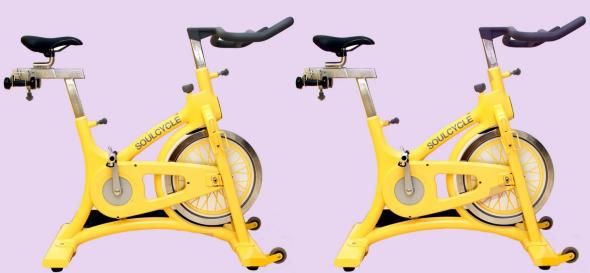This post originally appeared in Inc.
Designing a bike that doesn’t go anywhere is harder than you think.
Just ask Melanie Whelan, CEO of spin class chain SoulCycle. In 2012, six years after the company’s founding, SoulCycle set out to design a stationary bike from scratch to replace the Schwinn bikes used in its classes. Co-founders Elizabeth Cutler and Julie Rice wanted a bike designed specifically around SoulCycle’s unique exercise experience that involves elements of dance and weight training. “Functionality was the primary driver behind the design of the bike,” Whelan says.
Today, SoulCycle’s investment in proprietary equipment looks like a smart one. The company generated $112 million in revenue in 2014, $26.5 million in net income, and SoulCycle’s branded bikes fetch $2,200 a piece from consumers who want one in their homes.
For the design of SoulCycle’s bike, the company turned to boutique fitness designer Eric Villency, CEO of Villency Design Group. Here are three crucial design elements that Villency and SoulCycle incorporated to help reinvent the stationary wheel.
One of the first design decisions for SoulCycle’s bike was to extend the distance between the handlebars and seat relative to many other stationary bikes, forcing riders to exercise more than just their legs. “That enables you to extend your upper body and pull from your core throughout the entire workout, so you’re not not pushing from your quads as much,” says Whelan.
Because SoulCycle workouts incorporate a number of “signature moves” similar to pushups and other exercises, the bikes needed to withstand the movement of the company’s riders, regardless of their height and weight. To make the bikes sturdy enough for this movement, Villency designed a carbon steel frame weighing 137 pounds, 10–30 percent heavier than comparable bikes. “Having that weight and stability was a big part of the thought process behind the design,” Villency says.
With 12 different people riding each SoulCycle bike per day, minimizing wear and tear on the bike was one of the design team’s key objectives. Villency used hand-sanded joints that allow sweat to naturally roll off the frame, preventing rust that comes with unsanded weld points. The chain guard was also designed with an extra tight seal to keep sweat and moisture out of the chain area. “That’s a level of attention to detail that you just don’t find in indoor bikes,” Villency says. “Most of them are utilitarian and look like soviet spies made them.”
Though it’s been three years since SoulCycle debuted its bike, the design continues to evolve to account for changes to the company’s workout. For example, because riders are using heavier hand weights during the routines, the company has redesigned the weight holder on the frame of the bike.
“Functionality and innovation together are really the top priority,” Whelan says. “We continue to challenge ourselves to do it better each time.”
